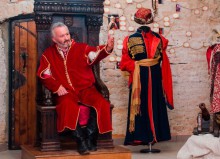An exhibition of reconstructed 16th- and 17th-century Ukrainian costumes, entitled At the Ostrozky Princely Court, has opened at the art gallery of the National University of Ostroh Academy. Its exhibits have come from private collections of Iryna Pohorzhelska and Yan Pohorzhelsky as well as local historian Mykola Bendiuk.
“We wanted to show how families looked in the 17th century. Children’s costumes were similar to those of the adults, the complex clothing culture continued different traditions of combining colors and fabrics. Our sources often mention that even noblewomen were doing needlework. History shows that the needlework tradition passed down in families from generation to generation, and Ukraine has stayed one of the largest centers of embroidery ever since,” we learned from Pohorzhelska who had reconstructed the clothing items on display.
The craftswoman had to spend a lot of time studying historical sources, mostly ancient books, inventories, portraits, archaeological studies and museum collections. The main source was a 1616 inventory of goods that belonged to the Ostrozky princes and were held in Dubno castle.
Earlier, Pohorzhelska worked as auditor, but has quit her job to devote herself to recreating ancient clothes full-time. “In fact, this is a family business for me. My great-grandmother met my great-grandfather at a tailoring course, and I probably inherited this liking for sewing and embroidery from them. Even one piece can take a long time to reconstruct. We have very few fabrics now that meet the technical requirements of the era, I mean the 16th and 17th centuries,” Pohorzhelska told us.
Besides, the exhibition presents everyday objects and weapons, including authentic chairs, a dresser, a throne, a 17th-century scriptorium’s equipment, and a silver chess set. “This exhibition reflects the decades-long work and achievements of all those inspired by Ostroh and the Ostroh Academy,” Bendiuk remarked.
The exhibition, hosted by the gallery of the National University of Ostroh Academy, will run till April. “The age of the Ostrozky princes was quite long. Ukrainian fashion trends reflected wider European developments, combining Hungarian, Polish, Turkish, and French influences. In addition, people displayed a creative approach to tailoring, remaking, say, French-style pieces to better suit their preferences or wearing a Turkish belt with a Hungarian dolman. It would be unacceptable abroad, but paintings show Ukrainian fashion trends penetrating Western Europe as early as the 17th century. We are not going to Europe, we are returning to it,” Pohorzhelska added in closing her commentary.








